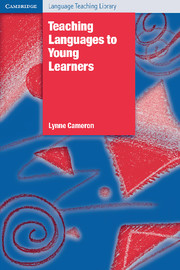Book contents
- Frontmatter
- Contents
- Preface
- Acknowledgements
- 1 Children learning a foreign language
- 2 Learning language through tasks and activities
- 3 Learning the spoken language
- 4 Learning words
- 5 Learning grammar
- 6 Learning literacy skills
- 7 Learning through stories
- 8 Theme-based teaching and learning
- 9 Language choice and language learning
- 10 Assessment and language learning
- 11 Issues around teaching children a foreign language
- References
- Index
11 - Issues around teaching children a foreign language
Published online by Cambridge University Press: 05 May 2010
- Frontmatter
- Contents
- Preface
- Acknowledgements
- 1 Children learning a foreign language
- 2 Learning language through tasks and activities
- 3 Learning the spoken language
- 4 Learning words
- 5 Learning grammar
- 6 Learning literacy skills
- 7 Learning through stories
- 8 Theme-based teaching and learning
- 9 Language choice and language learning
- 10 Assessment and language learning
- 11 Issues around teaching children a foreign language
- References
- Index
Summary
Review of ideas
The book has aimed to put learning in the centre of the frame, and to use what we know about learning as a key to more effective language teaching. Frameworks for thinking about the language and about classroom activities have been constructed and used in analysis and application. This final chapter begins with a review of these constructs that pulls together the central ideas of the book.
Learning
At the root of learning is the process of making meaning out of participation in the social world. As children's minds stretch to find meanings in new experiences, so learning occurs.
Meaning and learning can be seen as both social and conceptual. In making sense of their experiences, minds stretch to make accumulating and conflicting information coherent by re-organising internal categories and the informal theories that hold them together. In making sense of other people and what they do, minds stretch to understand intentions and other people's minds.
Language and learning are interdependent – language leads to learning through enabling participation in the social world and the expressing and sharing of meanings; learning increases the power of an individual's language resources.
A foreign language
Learning a foreign language is different from learning the first language, even for children at the young end of our age range. It is different because the first language is already a huge system that a child has in place; because, in comparison, the child will encounter such a small amount of the foreign language; and because it is ‘foreign’ – often the language ‘belongs’ to people in a distant and strange culture.
- Type
- Chapter
- Information
- Teaching Languages to Young Learners , pp. 241 - 246Publisher: Cambridge University PressPrint publication year: 2001

